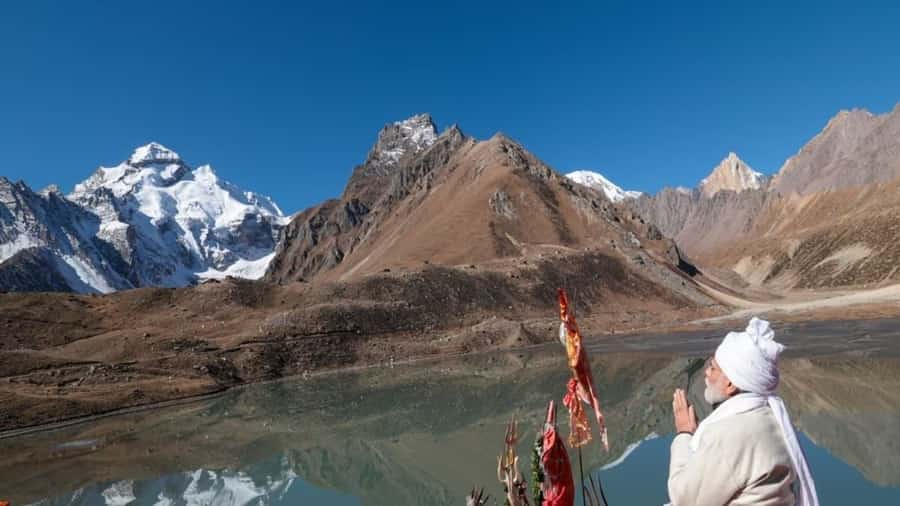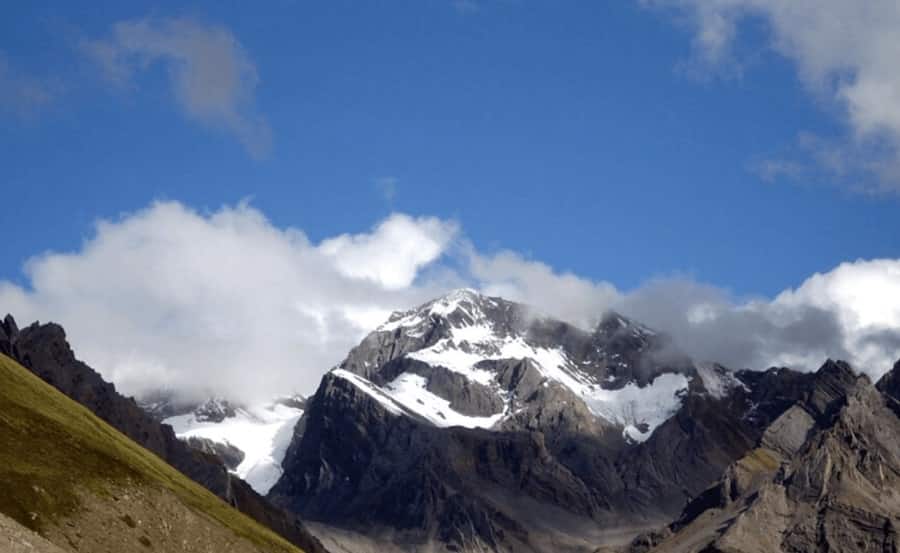Last Updated on September 11, 2024
Adi Kailash, also known as Chhota Kailash or Baba Kailash, is a prominent mountain located at an altitude of 5,945 meters above sea level on the Indo-Tibetan border in Uttarakhand, India. It stands as one of the five sacred Kailash peaks, collectively known as Panch Kailash. The other four are Kailash Mansarovar, Mani Mahesh, Kinnaur Kailash, and Srikhand Mahadev Kailash.
Location
Adi Kailash, also known as Chhota Kailash, is a striking mountain located in the Himalayas, straddling the Indo-Tibetan border in the Pithoragarh district of Uttarakhand, India. It sits at an elevation of 5,945 meters above sea level. Adi Kailash is positioned near the base camp of Dharchula and close to the last village in India, Kuti, which serves as a starting point for pilgrims. The region is known for its remote and rugged terrain, adding to its mystical charm.

History and Significance
Adi Kailash holds immense spiritual significance in Hinduism, being revered as a sacred peak and a divine abode. This mountain is considered a mirror image of Mount Kailash in Tibet and is part of the revered group of peaks known as Panch Kailash, each symbolizing different aspects of Lord Shiva’s domain.
Mythological Roots
According to Hindu mythology and Puranas, Adi Kailash was a crucial site in the grand narrative of Lord Shiva’s marriage to Goddess Parvati. This event, starting from Kailash Mansarovar, is believed to have culminated at Adi Kailash. The mountain is also associated with numerous legendary figures, including:
- Ravana: The demon king and devoted follower of Shiva meditated here, gaining great strength and power as a result.
- Pandavas and Sage Ved Vyas: During their exile, the Pandava brothers, along with Sage Ved Vyas, are said to have meditated at Adi Kailash, seeking spiritual enlightenment.
The mountain is celebrated for its cosmic energy, which devotees believe can transform negative thoughts and lead to inner peace.
Om Parvat

Located near Adi Kailash, Om Parvat is a sacred peak renowned for its distinctive shape that resembles the Hindu symbol “Om.” This peak stands at approximately 5,590 meters and holds special spiritual significance.
Significance and Legends
- Symbolic Shape: The shape of Om Parvat is thought to be an auspicious sign, reflecting the divine presence.
- Legendary Status: It is believed to be one of eight mountains that display the Om symbol, with this being the only one discovered so far.
The proximity of Om Parvat to Adi Kailash enhances the spiritual ambiance of the region, making it a notable site for pilgrims.
Adi Kailash Yatra Circuit
The Adi Kailash Yatra is a sacred pilgrimage that traverses several important sites:
- Dharchula: The base camp for the trek, where accommodation and basic facilities are available.
- Kuti Village: Named after Mata Kunti, it is the last village on the Indian side and serves as a starting point for the trek to Adi Kailash.
- Jolingkong: The base camp for Mount Adi Kailash. From here, pilgrims can undertake treks to various sites such as Parvati Sarovar and Gauri Kund.
- Parvati Sarovar: Located about 2-3 km from Jolingkong, this lake is believed to be where Goddess Parvati bathed. It offers stunning reflections of Mount Adi Kailash.
- Gauri Kund: Situated at an elevation of approximately 5,000 meters, this small, chilled water body is considered sacred and is visited after trekking from Jolingkong.
- Shiv Parvati Temple: Located next to Parvati Sarovar, this temple is dedicated to Lord Shiva and Mata Parvati.
Panch Kailash
The term “Panch Kailash” refers to the five sacred peaks across the Himalayas, each bearing the name “Kailash” and associated with Lord Shiva. The five peaks are:
- Kailash Mansarovar: The primary and most significant peak, located in Tibet, considered the ultimate abode of Lord Shiva.
- Adi Kailash: Known as the second Kailash, situated in Uttarakhand, India, and a replica of Mount Kailash.
- Shrikhand Mahadev Kailash: Located in Himachal Pradesh, this peak is also revered in Hindu traditions.
- Kinnaur Kailash: Situated in the Kinnaur district of Himachal Pradesh, another important sacred peak.
- Manimahesh Kailash: Found in Himachal Pradesh, this peak is significant for its spiritual connections.
Must-Visit Places
- Adi Kailash: Sacred mountain revered as Lord Shiva’s abode. Offers stunning landscapes and a serene atmosphere.
- Om Parvat: Mountain shaped like the Om symbol, significant for its unique formation and spiritual meaning.
- Kuthi Yangti: Scenic village known for its traditional Kumaoni culture and beautiful views.
- Jolingkong: High-altitude area providing panoramic Himalayan views, part of the trek route.
- Madhyamaheshwar: Sacred shrine dedicated to Lord Shiva, located on the pilgrimage route.
- Gwalum: Traditional village offering cultural experiences and scenic beauty.
- Nabhidhang: Remote area with stunning Himalayan vistas and a tranquil setting.
Route Map
The route to Adi Kailash involves several stages:
- Delhi to Dharchula: Travel from Delhi to Dharchula by road or a combination of train and taxi. Dharchula serves as the base camp.
- Dharchula to Kuti Village: From Dharchula, trek or travel by road to Kuti, the last village on the Indian side.
- Kuti Village to Jolingkong: The trek from Kuti to Jolingkong is approximately 20-25 km, passing through scenic and rugged terrain.
- Jolingkong to Adi Kailash: From Jolingkong, the trek to Adi Kailash involves visiting key sites such as Parvati Sarovar and Gauri Kund.
Weather
Adi Kailash experiences extreme weather conditions due to its high altitude:
- September: The temperatures range from -4°C to 23°C. The weather is generally cold with potential rainfall, so light woolen clothes are recommended.
- Seasonal Variations: Summers (May to June) are relatively pleasant, while winters (October to April) can be harsh with heavy snowfall and sub-zero temperatures.
Best Time to Visit
The ideal time for the Adi Kailash Yatra is from mid-May to mid-October. The weather is more manageable during these months, with summer and early autumn being the best times to undertake the trek.
How to Reach
- By Air: The nearest airport is Pantnagar Civil Aerodrome, located about 301 km from Dharchula.
- By Rail: Tanakpur Railway Station is the closest railhead, approximately 239 km from Pithoragarh.
- By Road: Regular buses run from ISBT New Delhi to Kumaon regions like Champawat and Tanakpur. From these points, local taxis or public transport can be used to reach Dharchula.
Travel Tips
- Physical Fitness: Ensure you are physically fit and obtain a medical fitness certificate before the journey. High altitudes and rugged terrain require good stamina.
- Permits and Identification: Carry a valid government-issued ID (Aadhar Card, Passport, Voter Card, or Driving License). Foreign nationals should check for specific regulations.
- Weather Preparation: Pack accordingly for the cold and potentially wet weather. Light woolen clothing is recommended for September.
- Health Precautions: Acclimatization is essential. Be aware of altitude sickness symptoms and seek medical help if needed.
- Emergency Services: In case of natural calamities, evacuation by helicopter might be necessary, and costs will be borne by the traveler, subject to district administration permissions.
FAQs
- What is Adi Kailash? Adi Kailash is a sacred mountain located in Uttarakhand, India, and is considered a replica of Mount Kailash in Tibet. It is part of the Panch Kailash and holds significant spiritual importance in Hinduism.
- How high is Adi Kailash? Adi Kailash stands at an elevation of 5,945 meters above sea level.
- What is the best time to visit Adi Kailash? The best time to visit Adi Kailash is from mid-May to mid-October, with summer and early autumn offering the most favorable weather conditions.
- How do I reach Adi Kailash? You can reach Adi Kailash by flying to Pantnagar Civil Aerodrome or taking a train to Tanakpur Railway Station, followed by road travel to Dharchula. From Dharchula, you need to trek or travel by road to Kuti Village and then to Jolingkong.
- What should I pack for the Adi Kailash Yatra? Pack light woolen clothes, trekking gear, and personal medications. Prepare for cold weather and potential rainfall.
- Are there any health precautions to take? Yes, physical fitness is crucial due to the high altitude. Obtain a medical fitness certificate and be mindful of altitude sickness symptoms.
- Are foreign nationals allowed to visit Adi Kailash? Foreign nationals must comply with specific regulations and permissions. Check with local authorities for eligibility and necessary permits.
- What is the significance of Om Parvat? Om Parvat is a peak near Adi Kailash with a shape resembling the Hindu symbol “Om.” It holds spiritual significance and is considered auspicious in Hindu traditions.
- What are the key attractions on the Adi Kailash Yatra? Key attractions include Mount Adi Kailash, Parvati Sarovar, Gauri Kund, Shiv Parvati Temple, and the surrounding breathtaking scenery.
- Is there a road connecting to Adi Kailash? Yes, the newly constructed Gunji-Lampiya Dhura Pass Road (GLDPR) has made access to Adi Kailash easier, reducing the trekking distance and travel time.
Adi Kailash remains a symbol of divine spirituality and rugged natural beauty, offering a unique pilgrimage experience that intertwines religious significance with the awe-inspiring landscapes of the Himalayas.
Recommended Tour:


 Call
Call WhatsApp
WhatsApp Enquiry
Enquiry